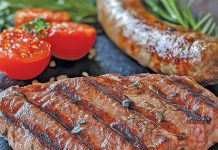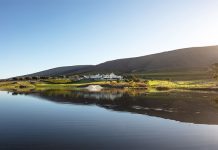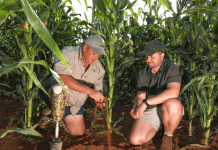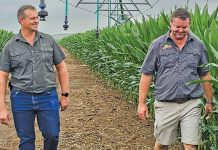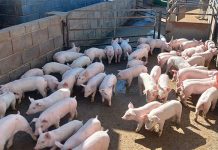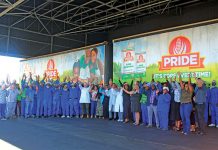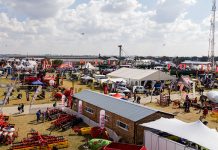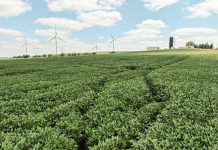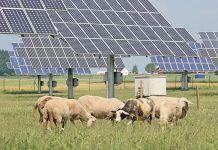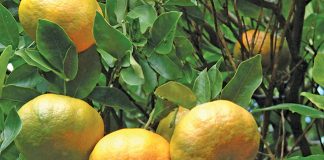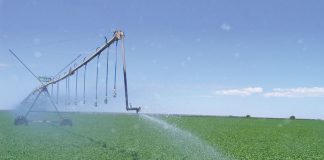
Photo: Glenneis Kriel
De Rustica Olive Estate, near De Rust in the Klein Karoo, made history when it won the Best in Class and Absolute Best Olive Oil awards at the 2023 EVOOLEUM Awards held in Spain. The estate’s olive oil was chosen from among almost 1 000 samples entered into last year’s competition.
The awards evaluate and acknowledge the highest-quality extra-virgin olive oils (EVOOs) in the world.
De Rustica also won gold medals for all the EVOOs it entered into the 2023 SA Olive Awards, as well as gold medals for both its EVOOs entered into last year’s New York International Olive Oil Competition.
Dawie Durand, general manager of De Rustica, says the international recognition together with the current world shortage of EVOO has led to the farm receiving an influx of inquiries to export and expand its local footprint.
But supplying additional markets is easier said than done. Durand explains that De Rustica, and South Africa for that matter, only produces small volumes of EVOO in comparison with the main olive oil-producing countries, making it difficult to secure long-term international market space.
Following the acknowledgement of South African quality, De Rustica, with the assistance of other like-minded producers, has secured partnerships to overcome this challenge and secure sufficient volumes to supply the export market.
“The idea is to unite South African EVOO production under one premium quality brand, so that individual South African estates can partake in exporting through joining programmes where reliability and continued yearly supply of quality EVOO is guaranteed,” Durand says.
The winner
De Rustica won the EVOOLEUM competition with its De Rustica Olive Estate Collection Coratina.
Kallie Frey, olive production manager at De Rustica, says they never imagined they had a winner during the production season, as 2023 was a particularly wet year, following about seven years of drought. Yet everyone knew the Coratina was special after tasting the first oil that came out of the press. “We were really excited when we tasted it.”
Coratina typically produces EVOO with a strong, intense, peppery taste that burns at the back of the throat due to its high polyphenol and antioxidant content.
The Coratina produced at De Rustica is more intense than European countries’ product, according to Frey, because of the huge fluctuation between night and day temperatures in the Klein Karoo. Day temperatures in summer, for instance, can reach 40°C and then go down to 16°C at night.
Frey points out that De Rustica’s Coratina can become so intense during very hot summers that they “soften” it during the oil-making process to ensure it continues to satisfy the demand of South African consumers, who generally prefer oils of a medium intensity. This is achieved by slowing down the crushing and pressing process.
Team effort
Frey ascribes the high quality of their EVOO to the team of people who produces it – from the irrigation specialists who get up in the middle of the night to irrigate the orchards to the pest scouts, fertiliser managers, pruners and pickers.
Then there are those who work in the oil press and those who market, sell and help to keep all the admin and finances together.
“Most of the people who work on this farm are well trained and passionate about their jobs. They not only know what to do but why they are doing it, and how they fit into the bigger success of the farm. This makes the job more fun,” Frey says.
He adds that the picking season is a time of great excitement on the farm: “It is almost as if people liven up when the picking season starts. Now that we have won the prize for the best olive oil in the world, we are motivated to reach new heights.”
The farm employs 50 permanent workers and provides seasonal work for almost all the adults in the Oudemuragie Valley for four months of the year. It usually employs 170 seasonal workers but employed 300 last season thanks to the large crop.
The availability of labour means that orchards at De Rustica are picked at optimal ripeness by hand, whereas orchards are harvested with machines because of labour shortages in most European countries and the US.
The picking season starts around the first of March and runs until July.
“We try to finish the harvest by the first week of July, as this gives the trees sufficient time to rest and build reserves for the next season. Production declines by 5% for every week waited after the first week of July. So, the earlier you finish harvesting, the better for the next harvest,” Frey says.
Picking is done throughout the day and the olives pressed as soon as possible, preferably on the same day, after being picked.
“The olives need to be cooled down to below 28°C before they can be pressed. The cooler the olives, the better the quality. Warm olives will produce more oil than cooler olives, but the quality will be lower,” Frey explains.
Water monitoring
Many farmers have “burnt their fingers with olive production” in South Africa. Frey attributes this to the misconception that the olive tree is a desert plant that can be grown without any water or nutrition:
“You can grow olive trees without any inputs, but trees that are neglected in this way will never reach their full potential and struggle to produce commercially viable yields.”
He identifies water as the biggest limiting factor when it comes to olive production. They harvested 1 000t of olives in 2023, with a forecasted harvest of another 1 000t for 2024, which is a huge milestone for them. Production amounted to about 350t in 2022 and the years before that, because of alternate bearing, droughts and other factors.
“Our five-year average is around 7t/ha, whereas we harvested an average of 11t/ ha last season,” Frey says.
The farm has 120ha under olive trees and roughly 300ha under irrigated pasture for sheep and silage production. Sheep and silage form an integral part of the viability of the farming enterprise by diversifying the market and countering climate risks. “Some years it is the olives and other years it is the sheep or silage that carries the farm financially,” Frey says.
Water levels are continuously monitored, with the irrigation of pastures being downscaled and eventually stopped when it becomes evident that the farm might run into a water shortage. “The aim is to always have enough water to irrigate the olive orchards. During a drought, you can buy feed in, but not irrigation water,” Frey says.
The farm has access to excellent quality water from the mountain, as well as dams to store water when the rivers flow strongly. Irrigation is supplied via double dripper lines at a rate of 2,3ℓ/h, spaced 600mm apart.

Frey says that they got rid of water-measuring technology a few years ago and now use a soil moisture-feel test to guide their irrigation decisions. For this, soil is taken with a drill at a depth of 300mm at each orchard once a week, then squeezed into a ball.
The soil is rated from one to five, where one is dry like dust, and five is like muddy water.
Soil that is moist and falls open is given a rating of two, whereas a three is given to soil that falls apart after pressure is applied to it with the thumb. Soil that produces a fingerprint after being pressed with the thumb is given a rating of four.
Frey says they try to maintain soil moisture levels between three and four from the first of August until the end of November: “The aim is to build sufficient moisture at a depth of up to 600mm to ensure good flower formation in spring and protect the crop against heatwaves in summer.”
He explains that it is part of the survival mechanism of the olive tree to shed flowers and olives when it suffers water stress.
Cultivar varieties
Aside from Coratina, De Rustica produces a variety of olive oil cultivars, with Favolosa (FS- 17) and Frantoio being the main varieties. Others include Arbequina, Delicata, Barnea
and Koroneiki. The farm also has 5ha of table olive varieties, such as Nocellara, Mission and Calamata.
Frey says De Rustica plans to expand olive production by another 15ha at the most:
“We will reach our full processing capacity of 180 000ℓ if we plant another 15ha of olive orchards. Going any bigger would not really make sense in the current business environment, as it will require huge investments in our processing capacity, while rendering us even more vulnerable to load-shedding and market fluctuations.”
The decision on which cultivars to plant in future is guided by the previous performance of each variety on the farm, expert advice and the chill requirements of the variety, which is defined as the number of continuous hours required between 7°C and 12°C for the cultivar to produce optimal budding.
Coratina and Frantoio, which are Italian varieties, require at least 600 chill hours, whereas Spanish varieties, such as Arbequina and Barnea, and Greek (Koroneiki) only require 300 chill hours. The Tunisian variety, Chemlali, which Frey is considering to plant, is said to be drought resistant and to have a chill requirement of only 125 hours.
Frey thinks that Arbequina is doing exceptionally well on the farm because of its low chill requirement. The variety starts to produce a small commercial yield from about three years after being planted, with yields thereafter reaching an average of 10t/ha from then on, and even higher once the trees are older than 10 years.
Frantoio and Coratina, which have a higher chill requirement, only produce commercial yields six to seven years after being planted, with Frantoio yields averaging around 8t/ha and Coratina around 9t/ha from then on.
These varieties are prone to alternate bearing, which means they might produce close to 16t/ha and more one year, but 8t/ha and less the next.
Light penetration
The first olive orchards planted at De Rustica were shaped into single leaders, but getting sufficient light into these trees later became a challenge.
“Central leader systems were introduced back in the day to enable mechanisation, but the owner of De Rustica, Rob Still, does not want to mechanise, because he understands the importance of creating jobs in small rural communities like ours,” says Frey.
To improve light penetration, the farm has switched to a free bush tree architecture, where the single leader is accompanied by two to three other strong upward-growing branches.
The farm also has 10ha of late cultivars planted in an open chalice system where the trees have multi-stem branches, as this tree architecture also facilitates good light penetration and air movement.
The trees are spaced 3m apart within rows and 6m apart between rows. “We will increase the spacing between trees in the rows to 4m if we plant again, as this would prevent the overshadowing of trees and improve light penetration. We reckon the larger trees will be able to give the same yields as trees planted at 6m by 3m,” Frey says.
The trees are kept short to enable people to pick olives and work the trees without using ladders.
Frey points out that the olive orchards are divided into four sections, with one of these sections heavily pruned each year by removing old branches, usually in winter to prevent sun damage later in the season.
The aim with this is to stimulate regeneration, alleviate the impact of alternate bearing, and improve light penetration and air circulation within the trees.
The rest of the orchards are thinned and topped.
“If we know we are heading for an off-season, for instance by looking at the number of flowers in spring, we might decide on doing a lighter pruning or thinning action to at least keep the crop we have. This would force us to take heavier action the year after, which can make pruning more difficult and would also negatively affect yields.”
The ideal, according to him, is to produce a tree that if the sun shines onto it at midday, the shadow of the tree will form the pattern of a tiger skin: “If the shadow is solid, you know light is not penetrating through the whole of the tree.”
Farming with nature
Weeds are used as cover crops inside the orchards to, amongst others, create a favourable environment for beneficial insects and organisms, and increase the soil organic matter.
The weeds are cut with a weed eater and thrown onto the plant rows to create a mulch.
Frey points out that they hardly use herbicides unless they have problems with couch grass or when weeds start to take over the mixed population of weeds.
Pruned plant material is chipped and spread onto plant rows, which helps to suppress weeds in the plant row, buffer the soil against extreme temperatures and build the organic content of the soil.
Compost tea, which is rich in a wide variety of living organisms, is sprayed onto the tree rows to improve soil health.
Fertigation is supplied at set intervals from September until January. The programme is based on the nutritional needs of plants during different stages of development and soil analysis results. The soil analysis is done every three years just before the harvest, as this is the time when the trees have removed most of the nutrients out of the soil.
Frey identifies post-harvest fertilisation as the most important part of the programme as this ensures there are sufficient nutrients in the soil for the next season.
“We usually use ammonium sulphate and potassium sulphate to supply nitrogen and potassium, because of the high pH of our soils, and mono-ammonium phosphate (MAP) to supply phosphorus.”
Trace elements, such as boron, are applied as foliar feed at the end of August, September and October, with another application made in April.
Leaf samples are taken twice a year, just before the picking season starts in March, and around October, before flowering, to identify and address nutritional shortages before they get out of control and negatively affect production.
Frey says the international shortage of olive oil has driven up olive oil prices from a low of R30 per litre back in 2012: “There is currently a strong demand for olive oil, but you need to ensure you offer excellent quality as this always finds a solid market and usually earns a premium.
“For now, however, I think the consumption of olive oil is entering an upward trend thanks to people becoming more aware of the health benefits of olive oil.”
Value of experimentation
Durand says that De Rustica is also set apart by the fact that the farm is willing to experiment with new products and ideas. The estate, for instance, started its own abattoir in November 2022 to add value to prime sheep produced on the farm.
The abattoir, under the management of Rooibaard Damonds, is a low-capacity facility preparing and positioning itself for the future. The farm is currently marketing limited volumes of ‘half lamb in a box’.
Derick Campher, manager of the sheep operation, says sheep production is split into two divisions: purebred Dohne Merinos and Dohne Merinos crossbred with Dormers, to produce terminal lambs for the meat market.
He explains that crossbreeding dual-purpose Dohne Merinos, bred for both wool and meat, with Dormers, which are exclusively used for meat production, produces offspring with heavier birthweights that reach their target weight faster.
The farm carries between 2 500 and 3 000 ewes, divided into four herds, which are rotated across the farm. Offspring that are not incorporated into the breeding herds are sold as store lambs when they weigh 30kg to 35kg, while the best 24 of each 250 lambs sold are selected and finished to be slaughtered at the farm of at a weight of 43kg to 45kg.
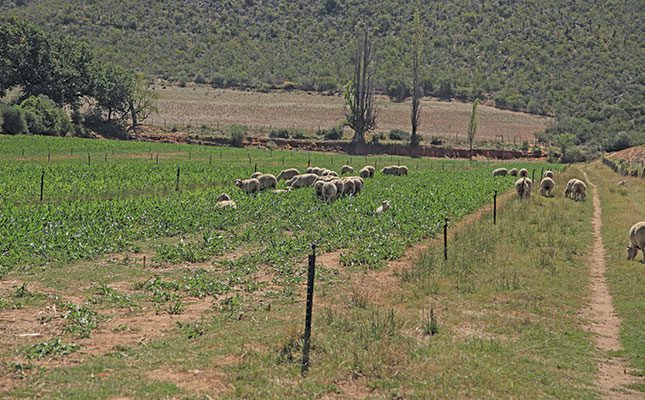
The meat is sold from the farm shop and restaurant, via online and physical sales.
The estate this year also released its first unfiltered EVOO. Durand points out that they produced this olive oil because it has 5% more polyphenols than ordinary EVOO, making it even healthier. The drawback of the unfiltered oil is that its shelf life is limited to three to four months, in comparison with traditional EVOO that can be kept for a year.
Durand says the success of De Rustica comes down to three things: good quality water, a strong workforce and a willingness to be successful: “You will find that most of the successful farmers in South Africa don’t get phased by the everyday challenges that are thrown at them.
“They are exceptional problem-solvers and people who find a way when all the odds are stacked against them.”
Email De Rustica at [email protected].

